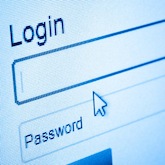 If you are in the habit of using passwords like 'password', 'qwerty' or '123456', you may be helping hackers and online thieves steal your data. Security experts have compiled a list of the 25 most common passwords – passwords that you should avoid.
If you are in the habit of using passwords like 'password', 'qwerty' or '123456', you may be helping hackers and online thieves steal your data. Security experts have compiled a list of the 25 most common passwords – passwords that you should avoid.
If you think using 'password' as your password is no big deal, then it's time to rethink.
Security experts have recently compiled a list of the worst passwords users can choose, and 'password' is at the very top of the list. Weak passwords make your information more vulnerable simply because hackers can guess them. It may be easier to pick a password that you don't have to think about, but it's a choice that you may come to regret.
To help you avoid common password choice mistakes that users make, management application provider SplashData has compiled a list of the 25 worst passwords to use:
- password
- 123456
- 12345678
- qwerty
- abc123
- monkey
- 1234567
- letmein
- trustno1
- dragon
- baseball
- 111111
- iloveyou
- master
- sunshine
- ashley
- bailey
- passw0rd
- shadow
- 123123
- 654321
- superman
- qazwsx
- michael
- football
No matter how sophisticated your security system is, a weak password gives hackers and online thieves an advantage. Helping all the users in your organization understand the importance of password strength will help you secure the IT systems in your organization.
If you're interested in learning more, please contact us so we can develop a comprehensive and custom security blueprint that meets your specific needs.
Reference: Worst Internet Passwords

 A joint operation between the United States Federal Bureau of Investigation (FBI), authorities in Estonia, and IT security firm Trend Micro recently put down a massive bot network that victimized an estimated 4-5 million users around the globe.
A joint operation between the United States Federal Bureau of Investigation (FBI), authorities in Estonia, and IT security firm Trend Micro recently put down a massive bot network that victimized an estimated 4-5 million users around the globe. With mobile devices becoming more accessible, many are finding it more comfortable and more productive to use these devices not only for personal purposes, but also for work. This may seem to be a good thing initially, but it also means that you have less control over the way these devices access your IT system. The best thing to do is to have a good IT security policy in place to make sure that important company data is not compromised.
With mobile devices becoming more accessible, many are finding it more comfortable and more productive to use these devices not only for personal purposes, but also for work. This may seem to be a good thing initially, but it also means that you have less control over the way these devices access your IT system. The best thing to do is to have a good IT security policy in place to make sure that important company data is not compromised.
